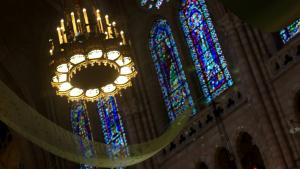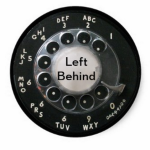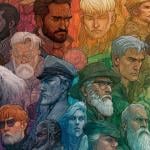I had the opportunity last week, at the invitation of a couple of Calvary members, to hear Barbara Brown Taylor speak at Virginia Theological Seminary. If you are unfamiliar with Barbara Brown Taylor, you should know she is an Episcopal priest who was plucked out of relative obscurity about fifteen years ago when Time Magazine named her one of America’s ten top preachers. Since that life changing event, Taylor has spent her career writing and teaching and speaking, to people like me who think it’s really exciting to spend a Friday night listening to a theological lecture.
In her recent talk, Taylor spoke to us about her new project, a book called Learning to Walk in the Dark. It seems that Barbara Brown Taylor thinks that darkness, as we know it, has gotten a bad rap in our society.
Consider: when the essay begins with the phrase “It was a dark and stormy night…” we know things are serious; we spend a lot of money on security lighting…those motion sensitive lights that go off as soon as there’s some movement we can’t see in the dark; all of us scrambled around last week, hoarding candles and battery operated illumination devices…why? Because we didn’t want to get stuck…in the dark.
It’s a little shady to be out in the wee hours of the morning, when it’s the darkest part of the night. It’s common sense to avoid dark alleyways and stick to well-lit sidewalks. Nightlights and floodlights and glow in the dark bedroom decorations are all around us.
No matter our age, it seems we are all a little bit scared of the dark.
Taylor pointed out, though, that in the original story of creation, it was darkness that provided the backdrop for God’s creation of the light…the story says that darkness covered the face of the deep as God stepped up with God’s divine paintbrush to paint the first stroke; darkness was there as a canvas when God began.
And, recounting stories of a smoky underground jazz club where she worked nights while putting herself through seminary, Taylor pointed out that there is a whole other world that happens after dark, a world that many of us never get to see.
She said we need darkness, not only for the life-giving REM cycles that happen in the dark, but for walking outside under a blanket of stars, far enough away from the big city that we can see clearly the Little Dipper and Cassiopeia and Orion, and in seeing the stars clearly through the darkness can, from time to time, see our own lives with a clarity we were missing before.
We need the darkness, she says. Without it, we can’t hope to see the light.
This morning we hear the familiar story of darkness…of a blind beggar named Bartimeaus, who appears in the tenth chapter of Mark’s gospel, a few chapters back from where we were last week.
Truth be told, I switched up the lectionary texts, so this story was actually our text for two weeks ago. We’re always doing something strange around here, though, so don’t act like you’re surprised.
Placing this story within the greater landscape of the Mark’s story, we encounter Jesus and his disciples right before the beginning of the week that would lead to Jesus’ crucifixion. Remember, that week began with Jesus’ triumphal entry into Jerusalem, where the people lauded him as Messiah, and the story went from there. Back up a few days and here we are with Jesus and his disciples visiting the city of Jericho.
Jericho is famous because…because of the battle of Jericho led by Joshua, yes. It was a bustling, busy city on an important port. We don’t know why Jesus and his disciples stopped in at Jericho, but we do know that by the time they left the city they had attracted quite a crowd of followers, people who were interested in Jesus’ message and were following the crowd as they pressed in around him, trying to hear what he was saying, hoping to witness a miracle, wanting to be part of this movement he was creating. Remember, at this point in the story, excitement was building; the people were clamoring to be close to Jesus.
The text tells us today that, as Jesus and the crowd were leaving Jericho, there was a blind beggar named Bartimeaus, son of Timeaus, sitting on the side of the road near the entrance to the city.
Of course there would be beggars sitting by the side of the road at the entrance to the city—that’s nothing surprising. In Jesus’ day there were no social services, no institutionalized way for a society to care for those who could not work to make a living. In fact, this WAS the way—begging—that one would earn enough to eat. It was part of the religious obligations of the day to give alms to the poor, and if you were begging for your living, you’d want to find the best and most heavily traveled stretch of road on which to beg.
So, though he couldn’t see, Bartimeaus knew something was going on near the gate. The text says that word got through the crowd to Bartimeaus that Jesus was walking by—that’s what all the fuss was about. Bartimeaus had clearly heard of Jesus…heard of what he was preaching and heard of the miracles he was performing all over the region, so he called out, trying to get his attention. “Jesus, Son of David, have mercy on me!,” he yelled from the sidelines. People tried to shush him—leave him alone, he’s important, but the blind beggar yelled even louder, “Jesus, Son of David, have mercy on me!”
Well, you heard the rest of the story. Jesus heard Bartimaeus’ call, and asked the crowd to clear to the sides so the man could come to Jesus. When he did, Jesus asked him what he wanted and the man asked Jesus to see—“let me see again,” he said. And, at the very end of today’s passage Jesus tells Bartimaeus the blind beggar to go on, your faith has made you well. Suddenly able to see again, Bartimaeus followed Jesus along the way.
It’s another one of those great healing stories, but if we read it carefully we should start to wonder about its deeper meaning, because Mark is not going to let us off with that easy categorization.
First, let’s note that there is a blind man in this passage who begins to see again.
However, the restoration of Bartimeaus’ sight is not the main focus of this passage. In fact, his healing seems to be almost an afterthought, tacked on at the end of the whole story. It seems like a blind man regaining his sight would be worth more than one little sentence at the end of the story, don’t you think? Unless the story is not really so much about one blind man regaining his sight at all.
Remember, the Gospel of Mark is one long story of Jesus Christ and his ministry on earth, so it would be rather shortsighted of us to read passages from the Gospel all by themselves. And, if we take a step back to look at the passage with a longer view, we can see that the story of Blind Bartimaeus, as he’s been called, is one bookend to a section of Mark that begins in chapter 8, verse 22, with the healing of another blind man. Remember that? Jesus heals a blind man in Bethsaida, the other book end of this little section of Mark. What happens in between is what gives us some clues about what our passage for today might mean.
And what happens in between is story after story of misunderstanding, most of it by Jesus’ disciples. They are trying to understand, but they just don’t get it. Jesus is talking about his death and resurrection; all the disciples can think about is building a monument in his honor. Jesus is talking about being salt and light in the world: all the disciples can do is argue amongst themselves about which of them is the most important. Jesus told rich people who came to follow him that they had to give up everything to be his followers; they went away grieving because they had so many possessions. In this section of Mark there is story after story of misunderstanding, of people who want to follow Jesus but who cannot see, for the life of them, what he is talking about. You guessed it…it’s almost like they are blind.
Though they could see just fine exactly what Jesus was doing in the light of day, they lived in a sort of darkness that would not allow them to fully understand what Jesus was trying to teach them.
And so, at the end of all of this, Mark introduces us to Bartimaeus, Blind Bartimaeus. And somehow, though he was blind, in the darkness of his situation, he could see what everyone else could not. He called out to Jesus, “Son of David, have mercy on me!,” and Mark would want us to know that this was profound. Baritmaeus called Jesus by a sacred, holy name…Son of David meant Messiah…and no one walking upright with Jesus in the light of day had the courage or understanding to see what was right in front of them, that Jesus was Messiah. Even the disciples couldn’t see who Jesus really was. But here Bartimaeus was, a blind beggar who lived in darkness, and he could see more clearly than any of the crowds of people following Jesus thinking they knew so well what he was saying.
There are, Mark would remind us, different kinds of blindness. Most of us can see the light of day clearly, but we spend a lot of time feeling around in the darkness to find the truth. And, ironically, in our darkest moments, we can very often see the light. Jesus healed these men who were physically blind, but there were perfectly healthy crowds all around them who couldn’t see clearly to save their lives. From his darkness the blind man Bartimeaus could see the situation clear as day.
When I was in seventh grade I heard Tony Campolo speak for the very first time. Many of you know Tony; he has preached here at Calvary many times. He’s a well-known speaker and author. Tony has a regular sermon he preaches wherever he goes, and usually that sermon includes the story of Agnes the prostitute. I am especially fond of this story since it takes place in Hawaii. I am going to retell his story here, although I will not spit all over the pulpit as he usually does. Here’s how it goes:
Tony Campolo flew to Hawaii to speak at a conference (maybe it was the conference where I first heard him in seventh grade!). The way he tells it, he checked into his hotel and tried to get some sleep. Unfortunately, his internal clock woke him at 3:00 a.m. The night was dark, the streets were silent, the world was asleep, but Tony was wide awake and his stomach was growling.
He got up and went for a walk in the darkness, looking for a place to get some breakfast. Everything was closed except for a grungy dive in an alley, so he went in.
As he sat there munching on his donut and sipping his coffee at 3:30 am, in walked eight or nine loud prostitutes just finished with their night’s work. They plopped down at the counter and Tony found himself surrounded by this group of smoking, swearing hookers. Then the woman next to him said to her friend, “You know what? Tomorrow’s my birthday. I’m gonna be 39.” To which her friend nastily replied, “So what d’ya want from me? A birthday party? Huh? You want me to get a cake, and sing happy birthday to you?”
The first woman said, “Aw, come on, why do you have to be so mean? I’m just sayin’ it’s my birthday. I don’t want anything from you. I mean, why should I have a birthday party? I’ve never had a birthday party in my whole life.”
Well, when Tony Campolo heard that, he said he made a decision. He sat and waited until the women left, and then he asked the guy at the counter, “Do they come in here every night?”
“Yeah,” he answered.
“The one right next to me,” he asked, “she comes in every night?”
“Yeah,” he said, “that’s Agnes. Yeah, she’s here every night. She’s been comin’ here for years. Why do you want to know?”
“Because she just said that tomorrow is her birthday. What do you think? Do you think we could maybe throw a little birthday party for her right here in the diner?”
A smile crept over the man’s face. “That’s great,” he says, “yeah, that’s great. I like it.” So they made their plans. Tony said he’d be back at 2:30 the next morning with some decorations and the man, whose name turns out to be Harry, said he’d make a cake.
At 2:30 the next morning, Tony came back. He had crepe paper and other decorations and a sign made of big pieces of cardboard that said, “Happy Birthday, Agnes!” They decorated the place from one end to the other and got it looking great. Harry had gotten the word out on the streets about the party and by 3:15 it seemed that every prostitute in Honolulu was in the place.
At 3:30 on the dot, the door swung open and in walked Agnes. Tony had everybody ready. They all shouted, “Happy Birthday, Agnes!” Agnes was stunned, her mouth fell open, her knees started to buckle, and she almost fell over.
And when the birthday cake with all the candles was carried out, that’s when she totally lost it. She sobbed and cried. Harry, who was not used to seeing a prostitute cry, gruffly mumbled, “Blow out the candles, Agnes. Cut the cake.”
After Agnes blew out the candles and everybody sang, they looked to Tony for what was next. So Tony got up on a chair and said, “What do you say that we pray together?” And there they are in a hole-in-the-wall greasy spoon, half the prostitutes in Honolulu, at 3:30 a.m., darkness outside, listening to Tony Campolo as he prayed for Agnes on her birthday.
When he finished, Harry leaned over, and with a trace of hostility in his voice, he said, “Hey, you never told me you were a preacher. What kind of church do you belong to anyway?”
Tony answered, “I belong to a church that throws birthday parties for prostitutes at 3:30 in the morning.”
Harry thought for a moment and said, “No you don’t. There ain’t no church like that. If there was, I’d join it. Yep, I’d join a church like that.”
Sometimes it’s in the darkness that we finally see the light.
Jesus walked all over Galilee trying to teach the people a new way of living, a way that welcomed the outcast and included the marginalized, a way that gave new life to the hopeless and created a new order in which no one was left behind. But no matter what he did, the people around him had a hard time seeing what it was Jesus described.
It seems, ironically, that it took a blind man, someone who couldn’t see at all, to paint the picture loud and clear for everyone else to see, too.
Like the disciples, if we follow Jesus around long enough, we’ll soon find that for all our attempts to shine a light on who he was, to illuminate and codify his message, to spotlight his work in the world, perhaps it’s the dark places, those unlikely ones, that allow us to see things the most clearly.
What have you suddenly seen in your own times of darkness?
Turns out Barbara Brown Taylor might be right, or at least it’s worth buying her book to see: it is the darkness in life that provides a canvas for the incredible picture of hope and salvation that Jesus came to show us. We need the darkness to see the light. And, if like Bartimaeus we have the courage to believe, we may just find that we can see most clearly…in the dark.
Amen.











